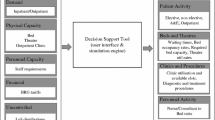Abstract
Emergency medical services (EMS) provide life-saving care and hospital transport to patients with severe trauma or medical conditions. Severe weather events, such as snow events, may lead to adverse patient outcomes by increasing call volumes and service times. Adequate staffing levels during such weather events are critical for ensuring that patients receive timely care. To determine staffing levels that depend on weather, we propose a model that uses a discrete event simulation of a reliability model to identify minimum staffing levels that provide timely patient care, with regression used to provide the input parameters. The system is said to be reliable if there is a high degree of confidence that ambulances can immediately respond to a given proportion of patients (e.g., 99 %). Four weather scenarios capture varying levels of snow falling and snow on the ground. An innovative feature of our approach is that we evaluate the mitigating effects of different extrinsic response policies and intrinsic system adaptation. The models use data from Hanover County, Virginia to quantify how snow reduces EMS system reliability and necessitates increasing staffing levels. The model and its analysis can assist in EMS preparedness by providing a methodology to adjust staffing levels during weather events. A key observation is that when it is snowing, intrinsic system adaptation has similar effects on system reliability as one additional ambulance.




Similar content being viewed by others
References
Ernst AT, Jiang H, Krishnamoorthy M, Sier D (2004) Staff scheduling and rostering: a review of applications, methods and models. Eur J Oper Res 153:3–27
McLay LA, Brooks JP, Boone EL (2012) Analyzing the volume and nature of emergency medical calls during severe weather events using regression methodologies. Socioecon Plann Sci 46:55–66
Auf der Heide E (2006) The importance of evidence-based disaster planning. Ann Emerg Med 47(1):34–49
Saul MH (2011) City fires EMS chief for storm response. Wall Street Journal. January 6, 2011
Institute of Medicine, Committee on the Future of Emergency Care in the United States Health System (2006) Emergency medical services: at the crossroads. National Academies Press, Washington
Cummings GE, Della Corte F, Cummings GG (2006) Disaster medicine education for physicians: a systematic review. Int J of Disaster Med 4:125–136
Barishansky RM, Langan J (2009) Surge Capacity: How to ensure your system is ready to respond to the victims in a large-scale incident. EMS World, 1 April 2009
Furbee PM, Coben JH, Smyth SK, Manley WG, Summers DE, Sanddal ND, Sanddal TL, Helmkamp JC, Kimble RL, Althouse RC, Kocsis AT (2006) Realities of rural emergency medical services disaster preparedness. Prehospital and Disaster Manag 21(2):64–70
Channouf N, L’Ecuyer P, Ingolfsson A, Avramidis AN (2007) The application of forecasting techniques to modeling emergency medical system calls in Calgary, Alberta. Health Care Manag Sci 10(1):25–45
Matteson DS, McLean MW, Woodard DB, Henderson SG (2010) Forecasting emergency medical service call arrival rates. Ann of Appl Stat 5(2B):1379–1406
Setzler H, Saydam C, Park S (2009) EMS call volume predictions: a comparative study. Comput Oper Res 36:1843–1851
Kc DS, Terwiesch C (2009) Impact of workload on service time and patient safety: an econometric analysis of hospital operations. Manag Sci 55(9):1486–1498
Alanis R, Ingolfsson A, Kolfal B (2010) A Markov chain model for an EMS system with repositioning, technical report. University of Alberta, Edmonton
Green LV, Savin S, Savva N (2010) Nursevendor problem”: personnel staffing in the presence of endogenous absenteeism. Technical report. Columbia University, New York
Restrepo M, Henderson SG, Topaloglu H (2009) Erlang loss models for the static deployment of ambulances. Health Care Manag Sci 12:67–79
Smith-Daniels V, Schweikhart SB, Smith-Daniels DE (1988) Capacity management in health care services: review and future research directions. Decis Sci 19:889–919
Maman S (2009) Uncertainty in the demand for service: The case of call centers and emergency departments, M.S. thesis, the Senate of the Technion, Israel Institute of Technology
Shen H (2011) Statistical analysis of call-center operational data: Forecasting call arrivals and analyzing customer patience and agent service. Wiley Encyclopedia of Operations Research and Management Science, Wiley (to appear), Available online: DOI: 10.1002/9780470400531.eorms0827
Acknowledgments
It is a pleasure to acknowledge Battalion Chief Henri Moore, Jr., Chief Fred C. Crosby, II, and Mr. Lawrence Roakes of the Hanover County Fire and EMS Department in Hanover County, Virginia, for the knowledge, experience, and data they provided to support this research effort. This research is supported by the National Science Foundation under Award No. CMMI-1054148. Any opinions, findings, and conclusions or recommendations expressed in this material are those of the authors and do not necessarily reflect the views of the National Science Foundation. The authors would also like to thank Dr. J. Paul Brooks at Virginia Commonwealth University for reviewing a draft of this paper and the anonymous referees for whose comments led to a significantly improved paper.
Author information
Authors and Affiliations
Corresponding author
Rights and permissions
About this article
Cite this article
Kunkel, A., McLay, L.A. Determining minimum staffing levels during snowstorms using an integrated simulation, regression, and reliability model. Health Care Manag Sci 16, 14–26 (2013). https://doi.org/10.1007/s10729-012-9206-y
Received:
Accepted:
Published:
Issue Date:
DOI: https://doi.org/10.1007/s10729-012-9206-y




